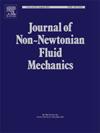Wrinkling of a viscoplastic plate on a viscous substrate
IF 2.8
2区 工程技术
Q2 MECHANICS
引用次数: 0
Abstract
We study the formation of wrinkles in a clamped viscoplastic plate overlying a thin viscous substrate, which is compressed horizontally. When the plate is purely viscous, the compressive force in the plate is constant and is set by the velocity boundary conditions. The wavelength of the emergent wrinkles depends on the thicknesses of the two layers and the ratio of the viscosities. As the domain length is reduced relative to the characteristic wavelength, the spatial profile and growth rate start to depend heavily on the domain length and imposed clamped boundary conditions. Introducing a yield stress to the plate initially increases the compressive force, proportional to the Bingham number, due to the requirement for the plate to be yielded throughout the domain. As the bending moments increase in the plate, the compressive force is relieved and a transition occurs where the plate begins to yield through bending rather than compression. During this transition, the plate is dominated by plugged, unyielded regions leading to localisation and the formation of straight-sided wrinkles.
粘塑性板在粘性基材上起皱
我们研究了夹紧粘塑性板上的薄粘性基材,这是水平压缩皱褶的形成。当板为纯粘性时,板内的压缩力是恒定的,由速度边界条件确定。出现皱纹的波长取决于两层的厚度和粘度的比例。随着畴长相对于特征波长的减小,空间轮廓和增长率开始严重依赖于畴长和施加的箝位边界条件。由于要求板在整个区域内屈服,向板引入屈服应力最初会增加与宾汉姆数成正比的压缩力。当板中的弯矩增加时,压缩力被解除,并且在板开始通过弯曲而不是压缩屈服的地方发生转变。在这一转变过程中,板块主要由堵塞的、未屈服的区域主导,导致局部化和直边褶皱的形成。
本文章由计算机程序翻译,如有差异,请以英文原文为准。
求助全文
约1分钟内获得全文
求助全文
来源期刊
CiteScore
5.00
自引率
19.40%
发文量
109
审稿时长
61 days
期刊介绍:
The Journal of Non-Newtonian Fluid Mechanics publishes research on flowing soft matter systems. Submissions in all areas of flowing complex fluids are welcomed, including polymer melts and solutions, suspensions, colloids, surfactant solutions, biological fluids, gels, liquid crystals and granular materials. Flow problems relevant to microfluidics, lab-on-a-chip, nanofluidics, biological flows, geophysical flows, industrial processes and other applications are of interest.
Subjects considered suitable for the journal include the following (not necessarily in order of importance):
Theoretical, computational and experimental studies of naturally or technologically relevant flow problems where the non-Newtonian nature of the fluid is important in determining the character of the flow. We seek in particular studies that lend mechanistic insight into flow behavior in complex fluids or highlight flow phenomena unique to complex fluids. Examples include
Instabilities, unsteady and turbulent or chaotic flow characteristics in non-Newtonian fluids,
Multiphase flows involving complex fluids,
Problems involving transport phenomena such as heat and mass transfer and mixing, to the extent that the non-Newtonian flow behavior is central to the transport phenomena,
Novel flow situations that suggest the need for further theoretical study,
Practical situations of flow that are in need of systematic theoretical and experimental research. Such issues and developments commonly arise, for example, in the polymer processing, petroleum, pharmaceutical, biomedical and consumer product industries.

 求助内容:
求助内容: 应助结果提醒方式:
应助结果提醒方式:


